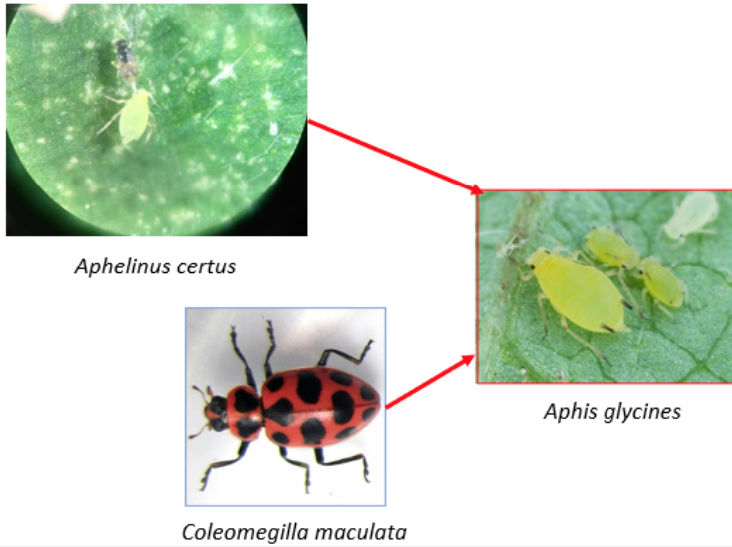We are delighted that the last two chapters of Élisée’s thesis have just been jointly published in the journal Microorganisms. He only just completed his PhD! They discuss the effects of beneficial microorganisms associated with soybean roots on the health of insect populations of the second and third trophic levels (an herbivore and its natural enemies).
Beneficial microorganisms such as arbuscular mycorrhizal fungi and rhizobium bacteria are known to modify plant performance traits through the supply of important nutrients, especially phosphorus and nitrogen. Previous studies looked at these interactions yielding variable results depending on the context. We examined at the cascading effects that beneficial organisms can cause on insects of the second and third trophic levels. We first wanted to confirm, in a controlled environment, the influence on the soybean aphid (Aphis glycines, second trophic level) of the tripartite symbiosis between an arbuscular mycorrhizal fungus (Rhizophagus irregularis), a bacterium (Bradyrhizobium japonicum), and the soybean plant (Glycine max) (First article). This study showed a significant increase in aphid colony growth in the presence of the double inoculant, mycorrhiza plus rhizobium and, albeit less so, in the presence of the rhizobium inoculant alone. This effect on the aphid is certainly a consequence of changes in plant chemistry induced by the microorganisms. The study shows that two symbionts can improve the performance of plants and phytophagous insects beyond what each symbiont can provide alone.

Secondly, we were interested in the effects of these same inoculants on the natural enemies of the soybean aphid, the predatory lady beetle (Coleomegilla maculata) and the parasitoid (Aphelinus certus) (Second article). The only significant result was with the parasitoid that showed a significant decrease in the rate of emergence from the pupal stage in the presence of the rhizobium inoculant. No difference was observed for any other fitness variable measured in either natural enemy.
In the light of the results of these consecutive studies, it appears that the confirmed advantages that microbe-plant symbioses confer upon the second trophic level are little transferred to the third.
- Dabré ÉE, Hijri M, Favret C. 2022. Influence on soybean aphid by the tripartite interaction between soybean, a rhizobium bacterium, and an arbuscular mycorrhizal fungus. Microorganisms, 10(6): 1196. DOI: 10.3390/microorganisms10061196
- Dabré ÉE, Brodeur J, Hijri M, Favret C. 2022. The effects of an arbuscular mycorrhizal fungus and rhizobium symbioses on soybean aphid mostly fail to propagate to the third trophic level. Microorganisms, 10(6): 1158. DOI: 10.3390/microorganisms10061158